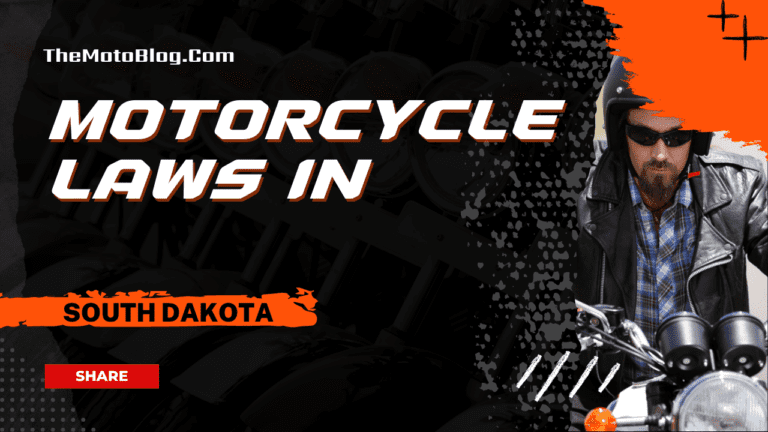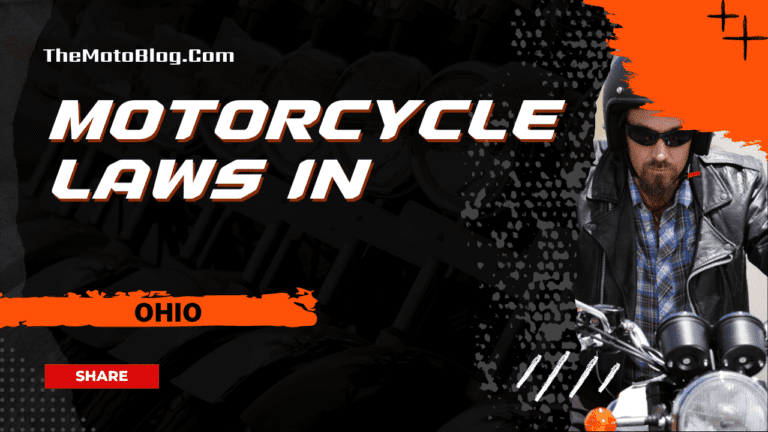Motorcycle Laws in Indiana: A Comprehensive Guide for Riders
Navigating the world of motorcycle laws can be a bit tricky, especially if you’re in Indiana. With a unique set of regulations and requirements, understanding these laws is crucial for every rider in the Hoosier State. Knowing your responsibilities – as well as your rights – on two wheels isn’t just about staying legal; it’s also about being safe.
Key Takeaways
- Motorcycle laws in Indiana require knowledge and understanding as they are unique and comprise various regulations and requirements.
- Motorcycle riders need an endorsement, proving they have passed written and practical exams. Key requirements include being at least 16, having a valid learner’s permit for at least 60 days, and passing both written and skills tests.
- The law makes a clear distinction between unendorsed and endorsed riders concerning their involvement in accidents.
- Indiana has a “partial” helmet law, only requiring riders under 18 to wear a helmet. However, helmets are heavily recommended for their safety benefits.
- Lane splitting, or motorcycles weaving between lanes of slow-moving or stuck traffic, is not legal in Indiana.
- Passengers on motorcycle must be at least five years old, and motorcycles must have footrests and handholds for passengers’ use along with a proper seat fixed behind the rider.
- Motorcyclists are also required to carry liability insurance coverage and must adhere to the same traffic laws as any other vehicle driver in Indiana.
- Indiana’s law is strict concerning riding under the influence (DUI). Penalties can range from potential jail time, fines up to $10,000, or even license suspension.
- Traffic violations can lead to points on the license, higher insurance premiums, and even suspension of driving privileges for repeat offenders.
- All motorcyclists under 18 must wear a helmet and protective glasses, goggles, or transparent face shields.
Motorcycle laws in Indiana incorporate various safety provisions, including mandatory helmet usage for riders under 18 and those with a learner’s permit, along with requirements for protective eyewear. When looking at Indiana’s neighboring states, a diverse set of regulations emerges. For example, motorcycle laws in Kentucky enforce helmet usage for riders under 21 and those with an instruction permit. Moving north, motorcycle laws in Michigan mandate helmets for riders under 21, while motorcycle laws in Ohio require helmets for novice riders and those under 18. Meanwhile, motorcycle laws in Illinois enforce helmet usage for riders under 18. The motorcycle laws in Wisconsin require helmets for riders under 18 and those with a learner’s permit. These variations in laws between Indiana and its neighboring states highlight the necessity for motorcyclists to be aware of the specific rules governing their region to ensure legal compliance and foster a culture of safety on the roads.
Understanding Indiana’s Motorcycle Laws
First off, let’s tackle the elephant in the room: helmet laws. In Indiana, only riders under 18 and those with a learner’s permit are legally required to wear helmets.
Moving on to eye protection. Regardless of your age or experience level, Indiana law mandates all motorcyclists to use protective eyewear when riding unless your bike has a windscreen.
Next up: licensing requirements. You can’t just jump on a motorbike and hit the road – you’ll need an endorsement added to your basic driver’s license in Indiana. Here are some key steps:
- Complete a written test
- Pass an on-cycle skills test
- Or complete an approved motorcycle safety course
Now let me shed some light on passenger restrictions as well. You might think anyone can hop onto the back of your bike for a ride around town but there are rules. Passengers must be at least five years old, and motorcycles must have footrests and handholds for passengers’ use along with a proper seat fixed behind the rider.
And finally, let me touch upon lane splitting – it’s something that many riders wonder about but here’s the deal: lane splitting is not permitted in Indiana.
The Importance of Motorcycle Endorsements in Indiana
Hopping on a motorcycle and hitting the open road is a thrilling experience. But it’s not just about hopping on and twisting the throttle; there are laws to follow – especially in Indiana. One of these critical laws centers around motorcycle endorsements.
In the Hoosier State, you can’t legally operate a motorcycle without one. Getting your motorcycle endorsement isn’t an unnecessary hoop to jump through; it’s about safety and legality. I’ve seen how understanding this requirement can save riders from hefty fines or even jail time.
An endorsement verifies that you’ve passed both written and practical exams demonstrating your ability to safely operate a motorcycle. It’s not merely about knowing how to balance or accelerate, but also understanding traffic rules specific to motorcycles.
According to the Bureau of Motor Vehicles (BMV), here are some key requirements for obtaining a motorcycle endorsement in Indiana:
- Be at least 16 years old
- Have held a valid learner’s permit for at least 60 days
- Pass written test
- Pass skills test
Without an endorsement, you’re not only breaking the law – you’re risking your life and others’. Research has shown that unendorsed riders are over-represented in accident statistics:
| Unendorsed Riders | Endorsed Riders | |
|---|---|---|
| Percentage involved in accidents | 59% | 41% |
Moreover, riding without an endorsement means invalidating your insurance coverage should you have an accident. This could lead to financial ruin if someone decided to sue following an accident where you were at fault.
Helmet Laws: Safety First in Indiana
In Indiana, they’ve adopted what’s known as a “partial” helmet law. This means that not every single rider is required by law to wear a helmet. Here are some quick facts:
- Riders under 18: Must wear a helmet
- Riders over 18: Can choose whether or not to wear a helmet
It’s important to note though, just because it’s legal doesn’t mean it’s safe. According to the National Highway Traffic Safety Administration (NHTSA), helmets reduce the likelihood of a fatal crash by 37%.
Let me break down some numbers for you:
| Age Group | Helmet Required |
|---|---|
| Under 18 | Yes |
| Over 18 | No |
Even if you’re over 18 and technically don’t have to wear a helmet according to state law, I’d strongly encourage you still strap one on before hitting the open road.
Despite its “partial” status, Indiana’s motorcycle helmet laws are stricter than those in Illinois and Iowa – two states with no mandatory helmet regulations at all.
In addition to helmets, riders under 18 years old must also sport protective glasses, goggles or transparent face shields while riding.
Lane Splitting Laws: Is It Legal in Indiana?
Lane splitting is not legal in Indiana. This term, if you’re new to biking lingo, refers to the practice of motorcycles weaving between lanes of slow-moving or stopped traffic. While it might seem like a time-saving maneuver for bikers, it’s not permissible under current Hoosier State regulations.
According to Indiana Code 9-21-10-6, motorcyclists must follow the same rules as other vehicles on the road. That includes sticking to your lane and resisting any urge you might have to squeeze past those slowpoke cars during rush hour! Instead, riders are advised to stay patient and wait their turn just like everyone else.
While I’m sure we’d all love a quick solution when stuck behind an endless line of cars, safety should always be our top priority. Lane splitting can be hazardous due both to motorists’ lack of awareness about this practice and the minimal space between vehicles.
Here’s what you need know:
- Motorcycle riders cannot pass vehicles within the same lane
- Riding between lanes or rows of vehicles is prohibited
- Violating these laws could lead to hefty fines or even license suspension
Passenger Regulations for Motorcycles in Indiana
When it comes to carrying passengers on motorcycles, Indiana has some specific laws in place. To start with, it’s mandatory for all motorcycle passengers to wear helmets if they’re under 18 years old. This law aims at ensuring the safety of younger riders who may be more vulnerable to injuries.
Now, let’s talk about equipment. In Indiana, a motorcycle must have a permanent and regular seat if you’re planning on carrying a passenger. Furthermore, if the passenger is seated behind the driver, there must be footrests available for use by the passenger. These measures are put into place to ensure that passengers can ride comfortably and safely.
Here are some key points:
- Helmet required for those under 18
- Motorcycle needs a permanent and regular seat
- Footrests needed if passenger is sitting behind
In addition to these requirements, I’d like to stress that both drivers and passengers need to adhere strictly to all traffic rules. For instance, lane splitting – riding between lanes of traffic or threading through cars – is not permitted in Indiana.
| Key Regulation | Description |
|---|---|
| Helmet | Required for those under 18 |
| Seat | Permanent and regular seat necessary |
| Footrests | Required if passenger sits behind |
Biker Rights and Responsibilities under Indiana Law
As a motorcyclist in Indiana, it’s crucial to understand your rights and responsibilities. I’ve spent time combing through Indiana’s motorcycle laws to provide you with the most accurate information.
Firstly, let’s talk about helmet laws. Indiana law requires all motorcyclists under 18 to wear a helmet and protective glasses, goggles, or transparent face shields. However, if you’re over 18, wearing a helmet is optional but recommended for your safety.
Moving on to insurance requirements – like any other vehicle operator on the road, motorcyclists are required by law to carry liability insurance coverage. This must include:
- $25,000 for bodily injury per person
- $50,000 for bodily injury per accident
- $10,000 property damage
Here’s an easy-to-read table for these values:
| Liability Coverage | Minimum Amount |
|---|---|
| Bodily Injury (per person) | $25,000 |
| Bodily Injury (per accident) | $50,000 |
| Property Damage | $10,000 |
Next up is licensing. If you plan on operating a motorcycle in Indiana, you’ll need an endorsement on your driver’s license or permit specifically stating that you are authorized to operate motorcycles.
Finally yet importantly is knowing about right of way rules. In Indiana:
- Motorcycles have the same rights as other vehicles.
- It’s illegal not to yield the right of way or obstruct a motorcycle.
- Lane splitting (riding between lanes of traffic) isn’t permitted.
DUI Rules and Penalties for Motorcyclists in Indiana
Indiana’s strict motorcycle laws extend to those who choose to ride under the influence (DUI). The Hoosier State doesn’t take drinking and driving lightly, especially when it comes to motorcyclists. Let’s delve into what you need to know about DUI rules and penalties for motorcyclists in Indiana.
Firstly, it’s illegal for anyone operating a vehicle in Indiana, including motorcycles, with a Blood Alcohol Concentration (BAC) of .08% or higher. If you’re under 21 years old, that limit drops significantly to just .02%.
For motorcyclists convicted of a DUI, the penalties can be quite serious:
- First offense: A misdemeanor charge carrying potential jail time up to one year and fines up to $5,000.
- Second offense within five years: Felony charge with potential imprisonment from six months up to three years and fines as high as $10,000.
- Third offense within five years: Also considered a felony with possible incarceration between two and eight years with maximum fines reaching $10,000.
| Offense | Charge | Possible Jail Time | Potential Fine |
|---|---|---|---|
| First | Misdemeanor | Up to 1 year | Up To $5K |
| Second | Felony | 6 months – 3 years | Up To $10K |
| Third | Felony | 2-8 Years | Up To $10K |
Now let’s talk about license suspension. It could range anywhere from 90 days for first-time offenders all the way up to two years if you’re convicted thrice within ten years. For repeat offenses or cases involving injury or death due to drunk riding; expect harsher consequences such as mandatory ignition interlock devices or vehicle forfeiture.
Indiana also requires completion of a certified substance abuse education course or treatment program before drivers’ licenses are reinstated.
How Traffic Violations Affect Motorcycle Riders in Indiana
It’s no secret, traffic violations can have a significant impact on motorcycle riders in Indiana. The Hoosier state has its fair share of law-abiding bikers, but like all motorists, they’re not immune to occasional infractions.
Traffic tickets aren’t just about paying fines. They can also lead to points on your license, higher insurance premiums, and even suspension of driving privileges for repeat offenders.
Now let’s break down how this works. In Indiana, the Bureau of Motor Vehicles (BMV) operates on a point system. Different violations carry different point values – from 2 points for minor offenses such as speeding up to 15 mph over the limit, up to 8 points for more serious offenses like reckless driving.
| Violation | Points |
|---|---|
| Speeding (<15 mph) | 2 |
| Disregarding signal | 4 |
| Tailgating | 6 |
| Reckless driving | 8 |
Once you rack up enough points (18 or more within two years), you could face a license suspension that ranges anywhere from one month to five years depending on prior convictions and the severity of your infractions.
So where does this leave motorcycle riders specifically? Well, it’s important to note that motorcyclists are subject to the same traffic laws as any other vehicle driver in Indiana. This means if you’re riding your motorcycle and commit a violation – whether it’s failing to signal a turn or running a red light – you’ll be hit with the same penalties as someone driving a car would be under similar circumstances.
But there’s another aspect we need to consider here: insurance rates. When you’ve got traffic violations on your record as a motorcyclist in Indiana, expect your premiums to skyrocket. Insurers see those tickets and points as an indication that you’re high risk and adjust their rates accordingly.
Conclusion: Navigating Motorcycle Laws in Indiana
Having a firm grasp of the motorcycle laws in Indiana is crucial for every rider. It’s not just about safety—it’s also about adhering to the rules that govern our streets and highways.
Well, helmet usage is necessary if you’re under 18 or still learning the ropes on a permit. But don’t think for a second that it’s an unnecessary burden once you’re older or fully licensed. Helmets can save lives.
Indiana law isn’t all about helmets, though. There are other aspects we need to consider:
- Eye protection: it’s mandated unless your motorcycle has a protective windscreen.
- Passengers: they’re allowed but must have their own seat and footrests.
- Lane splitting: steer clear! It’s illegal in Indiana.
I’ve covered some key points here, but remember that laws can change—so staying informed should be part of your routine as a responsible rider.
And let me add one final thought—I’ve been riding for years now, and while following traffic laws may sometimes feel like an annoyance, believe me when I say they exist for good reasons. They ensure not only your safety but also the wellbeing of everyone else on the road. So buckle up those helmets, keep your speeds legal and make sure you’re always visible on the road—the joys of riding are many; let’s not mar them with unnecessary risks or violations.
Motorcycle Laws in the US By States
If you liked this article, then please subscribe to our YouTube Channel for more Bike Videos. You can also find us on Instagram, Twitter and Facebook.
Disclosure: As an Amazon Associate, I earn from qualifying purchases. Read more about Amazon Affiliate Disclaimer.

Vishwanath Mathpati
I am Vishwanath Mathpati, a full-time Blogger and Motorcyclist from Bidar, Karnataka. I love writing about my Motorcycles Stories and Riding Gears on this blog.
Know More About Me.







